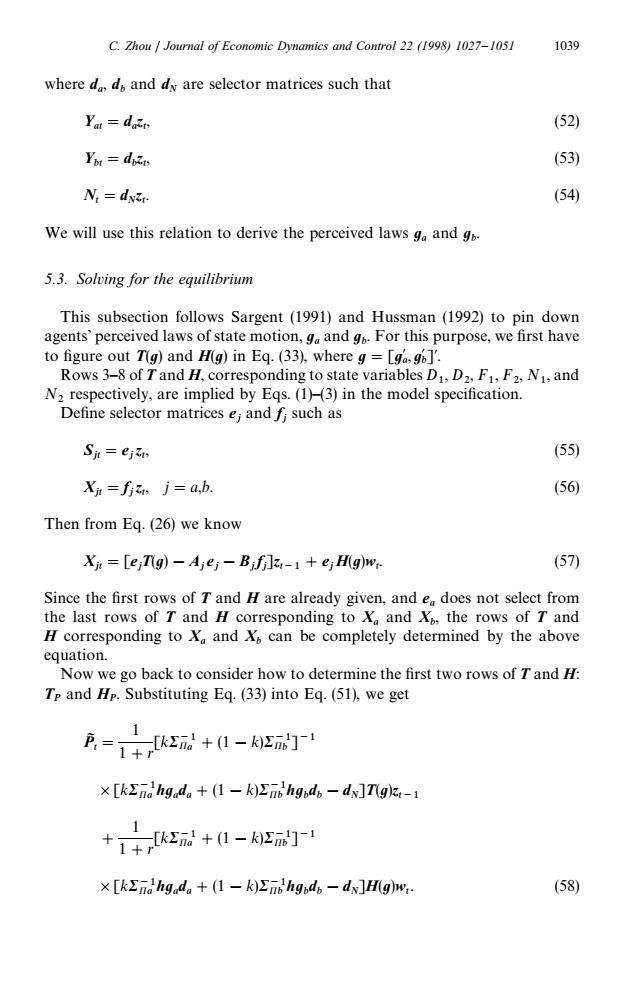正在加载图片...

C.Zhou Journal of Economic Dynamics and Control 22 (1998)1027-1051 1039 where dd and dy are selector matrices such that Yat =date (52) Yot =die (53) N:=dvzr (54) We will use this relation to derive the perceived laws ga and go. 5.3.Solving for the equilibrium This subsection follows Sargent(1991)and Hussman(1992)to pin down agents'perceived laws of state motion,ga and g For this purpose,we first have to figure out T(g)and H(g)in Eq.(33),where g [ga,g6]'. Rows 3-8 of T and H,corresponding to state variables D1,D2,F1,F2,N1,and N2 respectively,are implied by Eqs.(1)-(3)in the model specification. Define selector matrices e;and fi such as Si=ejin (55) Xit=fjz,j=a,b. (56 Then from Eq.(26)we know Xit=[ejT(g)-Ajej-Bifjl-1+ejH(g)wr. (57) Since the first rows of T and H are already given,and ea does not select from the last rows of T and H corresponding to Xo and Xp,the rows of T and H corresponding to Xa and Xo can be completely determined by the above equation. Now we go back to consider how to determine the first two rows of T and H: Tp and Hp.Substituting Eq.(33)into Eq.(51),we get 月=7十k2+1-2a ×[kΣno hgada+(1-k)Ens hgid-dw]T(gk-i +1+[k2+(1-k2]-1 x [kEnd hgada (1-k)En hgpd,-dx]H(g)w:. (58)where d a , d b and d N are selector matrices such that Yat"d a z t , (52) Ybt"d b z t , (53) Nt "d N z t . (54) We will use this relation to derive the perceived laws u a and u b . 5.3. Solving for the equilibrium This subsection follows Sargent (1991) and Hussman (1992) to pin down agents’ perceived laws of state motion, u a and u b . For this purpose, we first have to figure out T(u) and H(u) in Eq. (33), where u"[u@ a , u@ b ]@. Rows 3—8 of T and H, corresponding to state variables D1 , D2 , F1 , F2 , N1 , and N2 respectively, are implied by Eqs. (1)—(3) in the model specification. Define selector matrices e j and f j such as S jt"e j z t , (55) Xjt"f j z t , j"a,b. (56) Then from Eq. (26) we know Xjt"[e j T(u)!Aj e j !Bj f j ]z t~1#e j H(u)wt . (57) Since the first rows of T and H are already given, and e a does not select from the last rows of T and H corresponding to Xa and Xb , the rows of T and H corresponding to Xa and Xb can be completely determined by the above equation. Now we go back to consider how to determine the first two rows of T and H: TP and HP . Substituting Eq. (33) into Eq. (51), we get PI t " 1 1#r [kR~1 Pa #(1!k)RP~1b ]~1 ][kR~1 Pa hu a d a #(1!k)R~1 Pb hu b d b !d N ]T(u)z t~1 # 1 1#r [kR~1 Pa #(1!k)RP~1b ]~1 ][kR~1 Pa hu a d a #(1!k)R~1 Pb hu b d b !d N ]H(u)wt . (58) C. Zhou / Journal of Economic Dynamics and Control 22 (1998) 1027—1051 1039